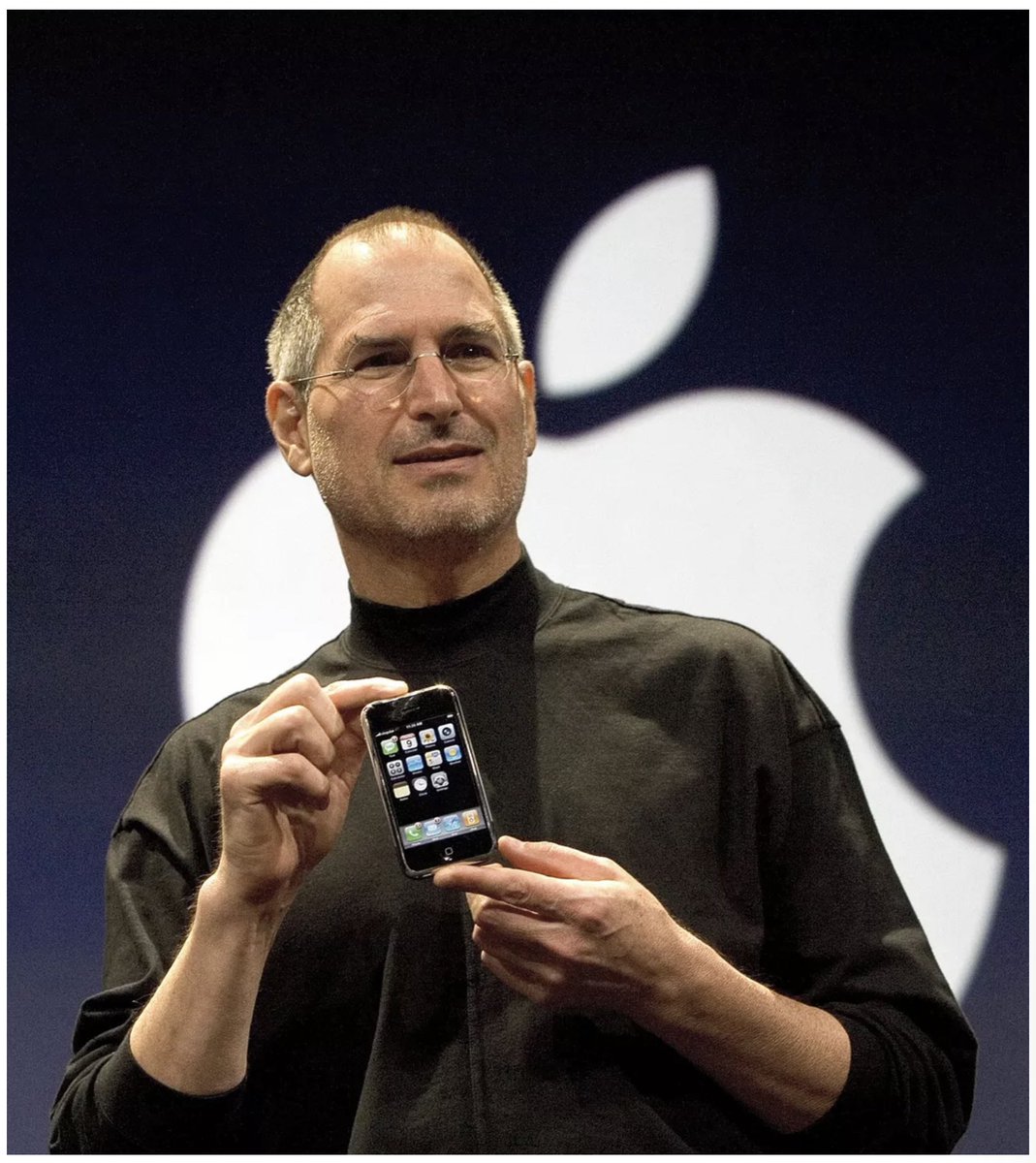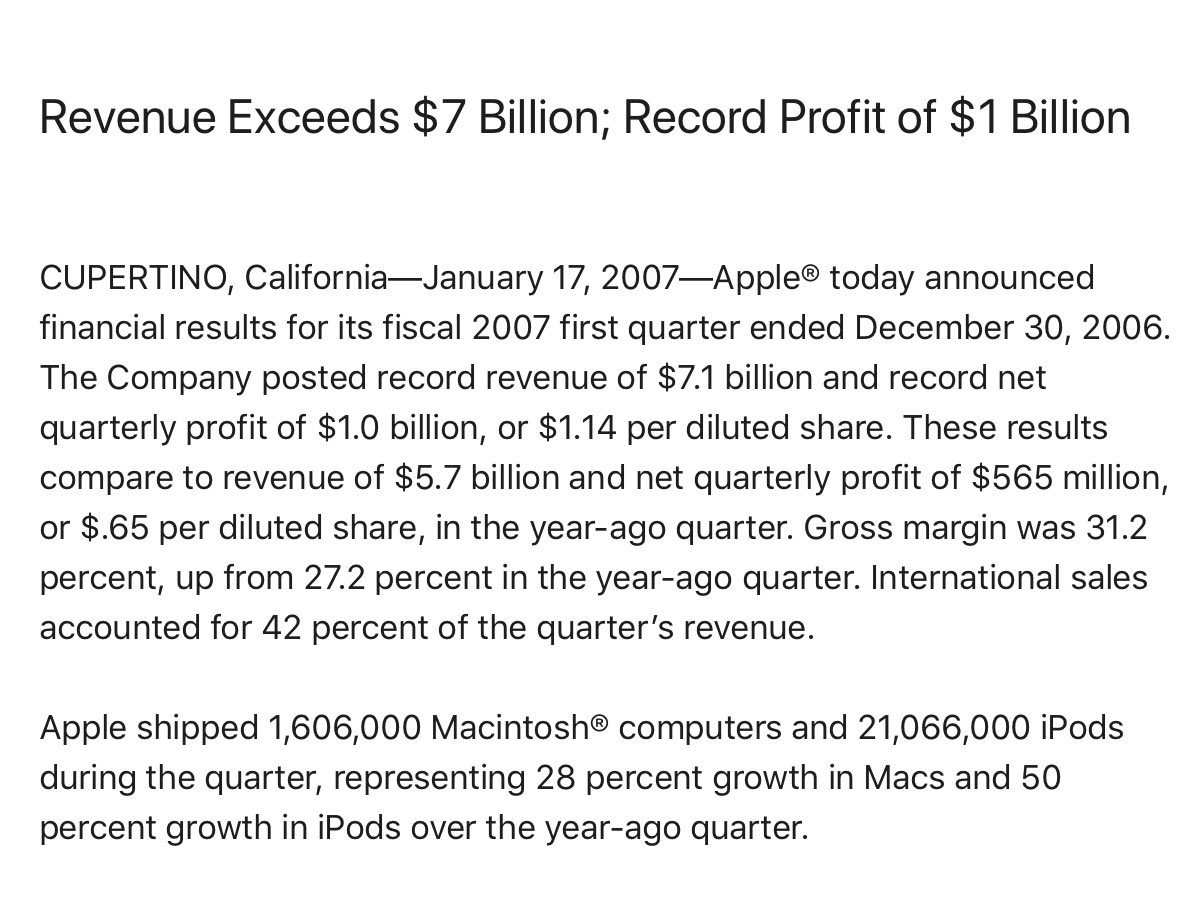
Today is the 13th anniversary iPhone announcement—easily one of the greatest launch events and moments of technology change in history. What was the "world" like at the time? When something changes the world so much it seems obvious in hindsight. That was not at all the case. 1/ 

2/ First, Apple itself was on a bit of a rebound with the iPod and iMac. But that only made Apple part of culture and healthy, but still a fringe player in computing. In all 2006 Apple sold about 5M Macs, which was strong for them but not compared to 235M PCs (98%share). 

3/ Apple in the midst of the "Get a Mac" advertising campaign. That’s the "I’m a Mac" and "I’m a PC". These ads were brilliantly executed and brutal relative to Microsoft. These really hit where it hurt the most. So much we had endless fights over if they were true. They were. 

4/ Google was really on a tear—growing spectacularly in search ads but we knew there was a desire to expand into display advertising which was Yahoo/MSN terrirory (Google acquired doubleclick in Spring 2007). Gmail took off, this month Docs/Sheets integrated. 

5/ Facebook was still quite early but was soon approaching 100M users and that was *huge* when all the endpoints were PCs and not phones, after opening up the service first to companies (like apple.com domains) and then to other mail addresses.
6/ Spring 2006, Amazon (an online retailer) re-launched Amazon Web Services introducing simple storage. Many remained puzzled by this at the time. It was not obvious at all where this was heading. Microsoft had just spun up RedDog under @rozzie including legend Dave Cutler—Azure! 

7/ Out of nowhere the idea of "virtualizing" a data center was becoming a thing in enterprise computing. VMWare was rocketing ahead building on an engineering/testing use case, putting forth a message that Windows Server was just one of many or any OS you could run. Ouch.
8/ The phone market was in a place very different from today. "Smart mobile devices" were growing at 30% on a small base. About 22M units shipped in Q4 split across more than a dozen makers. Windows Phone was absent from this list. 

9/ Mobile phones, not smart, were selling at insane numbers (4X PC Sales) and topped over 1B for the first time in 2006. Nokia was selling 350M units on their own. 

10/ The world thought SmartPhones would play out as a battle across Nokia, Motorola,RIM/Blackberry, & maybe Samsung, and Sony. And while they were exciting, the numbers were small. Blackberry was selling a phone, a service subscription with back end economics, and a platform.
11/ Where was Microsoft? Well we were really smarting from a long march since August 2001 when XP shipped. Finally, Vista would ship worldwide...after the iPhone launch. I had moved from Office to Windows a few months earlier and we were still figuring out how to "heal" the team. 

12/ The week of the iPhone announce was hectic because MacWorld in SF (where the launch was) overlapped with CES that week. I actually went back and forth to go to MacWorld. Suffice it to say, the audience (of fans) was not expecting and frankly ill-prepared for the announcement.
13/ Steve Jobs had previously been asked about phone. Why? Because the iPod was so successful it forced phone makers to try to do music and all those were awful. So why not assume Apple could do an amazing phone with its music. The start of "Apple should build a…"
14/ Jobs famously described a big barrier to building a phone were carriers, which he impolitely called orifices. Phone makers twisted into making crappy phones by "pipes". Only Blackberry navigated it b/c they promised a cut of subcription. allthingsd.com/20050602/carri… @waltmossberg
15/ The setup for the keynote did a textbook example of disparaging the competition and defining a new category. And like so many, he put out there that the iPhone would leapfrog the "competition". The graphics and use of a 2x2 is classic enterprise marketing :-) 





16/ Jobs referred to the internet capabilities of the phones as "the baby internet" which was entirely true. It was called WAP [sic and yikes] and was a funky HTML subset that no one was happy with, all over 2G speeds.
17/ Jobs went on to do an amazing demo which we now know worked by the slimmest of margins. The most interesting and critical part of the introduction AND the implementation was what Jobs said about the software. It was three main things:
18/ (1) Revolutionary user interface using touch. No one expected this and nearly *everyone* in the room was using a Blackberry or Treo and so thought this was going to be a problem. Technically the work would prove to be mind-blowing and patented! Mouse->Wheel->Touch...wow! 







19/ (2) Desktop [sic] class apps and networking. The choice of using "full OS X" to power the phone was brave, crazy, and ahead of its time for a bit.
Windows Phone/CE was based on a very old 16-bit version of Windows missing all these things. That was a huge problem.
Windows Phone/CE was based on a very old 16-bit version of Windows missing all these things. That was a huge problem.

20/ (3) Design. A lot of this discussion was really the start of Apple pushing a broad array of sensors and hardware capabilities while at the same time guaranteeing a software platform that would be coupled with deep software. Hint of the future to M1.
21/ There was no App Store yet. 3G was a year away. The OS didn’t even support copy/paste. No FLASH (huge)! No QWERTY keyboard would be the subject of endless debates. Once you had one though you’d be immediately swayed unless you worked on Wall St or the blue line. 

22/ In fact there’s even a roundup of all the reviews that got things wrong. Me personally, I remained skeptical of touch at announce. By the time I made it through the line I was done being skeptical. bgr.com/2016/07/01/iph…
23/ Then came 3G, the App Store, and copy/paste :-) The key thing is that the foundation of the iPhone was so big and bold that it took time to fill in. Importantly, neither Google nor Microsoft were heading on the right trajectory nor were Nokia, Sony, etc. Ars & FastCo reviews. 



24/ Even w/early reviews, Steve Jobs turned out to be right—iPhone was 5 years ahead of everyone. So far ahead no one really caught up. Today’s iPad, M1 Si, and more are all built on that foundation 13 years ago to over 1 billion active devices later. asymco.com/2018/02/27/the…
PS/ Oops sorry meant to include this one reminding us that it was also the announcement of AppleTV.
https://twitter.com/waltmossberg/status/1347933228406091777
PS/ Here’s the story of the demo done that day. This is an incredible view of just how not ready for prime time things were to show off all the magic. This is close to home for me :-) nytimes.com/2013/10/06/mag…
• • •
Missing some Tweet in this thread? You can try to
force a refresh




